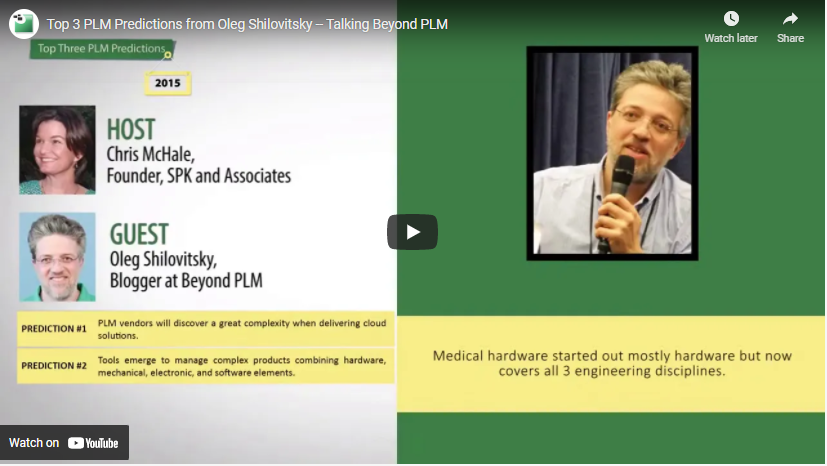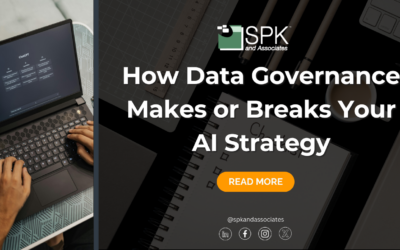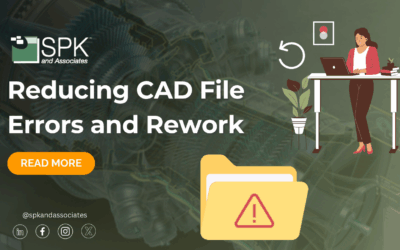The last time SPK and Associates co-founder Chris McHale spoke with PLM expert Oleg Shilovitsky, they discussed the difficulty of BOMs across engineering disciplines and across the product lifecycle. Here is their next discussion on the latest PLM news and trends around Aras and Autodesk.
Transcript:
Chris: Hi, this is Chris McHale, co-founder and COO of SPK and Associates Technology Services Company which is dedicated to accelerating product development and manufacturing companies. I’m here with Oleg Shilovitsky, who is a well-known blogger on product lifecycle management or PLM topics for the last five years. Oleg and I are presently doing a podcast about once a month where we dive deeper into some of his key topics from recent blogging posts. So Oleg you want to just take a moment to introduce yourself and then we’ll jump into our topic for today?
Oleg: Sure. Hello, everybody. I am Oleg Shilovitsky. I am blogging about product lifecycle management and related topics in engineering and manufacturing software. My blog will be on PLM.com.
Chris: So Oleg I thought today we would focus in on taking a look at some recent PLM player moves. You have just been attending the Autodesk conference in Boston and blogging quite a bit about that this week. There were some interesting tidbits that I noticed in there and some interesting things that Autodesk is doing that we could discuss. Then in addition, I thought we would also pick up Aras because they’re a very different PLM company. They have a different business model and technology model for PLM. Recently they were adopted by Airbus so they… I would say perhaps they haven’t been in the mainstream of the PLM industry but they certainly are in the mainstream now. If you’re in Airspace and PLM you’re in the mainstream, and Airbus is a very, very large enterprise. So that was a very interesting win for them.
So to start this off or kick it off, perhaps we’ll start with Aras. I wondered if you could just briefly describe for everybody what the technology model for PLM that Aras brings to the table and their business model as well because it is a bit different and not everybody may be familiar with it.
Oleg: Sure, absolutely. I think these two examples of both PLM system development from Autodesk and Aras PLM are representing very dynamic changes in the PLM industry. These two vendors and products are bringing some changes and probably interesting challenges for other vendors as well. Speaking about Aras, Aras has been around for the last 15 years but since 2007 Aras introduced something that they call enterprise open source.
In a nutshell, Aras provided their products for free and their license was free for the core product. They’ve been selling subscription for customers that want to get more support and updates. That is my view in a nutshell of the business model of Aras. We can agree or disagree with the open source statement, but it is certainly a different model that uniquely represented by Aras in the PLM ecosystem. From the technological viewpoint, Aras is, from my best knowledge, Microsoft based product. It uses Microsoft technology on both server side and until very recently it was also only Internet Explorer based product. But the last couple of versions they came with the additional browser support. As far as I know they are supporting Firefox and maybe even Chrome in the latest Aras version.
Chris: So Oleg, on the client side then, there isn’t a thick client? It’s just a purely inter-browser based client then?
Oleg: No, on the client side this is the browser based client. But the support for different browsers, it’s something that recently started to change.
Chris: Okay.
Oleg: It’s something probably worth checking with Aras.
Chris: I know that on the technology side, part of their approach to their customers are suggesting things like upgrading is easy, upgrading is free, also part of that business model but from a technology perspective that upgrades are not that big of a deal which of course in a traditional PLM industry or PLM software where upgrades are a huge big deal. So how do they technologically achieve that?
Oleg: Thank you for bringing this question about upgrades. From the technological standpoint, what I’ve known is that Aras is implementing something that they uniquely call model driven service reentered architecture. It sounds a little bit marketing, but on the technology level this is technology that creates a data model on top of a relational database. It’s not something very unique in the PLM world because in my view all PLM vendors are doing more or less the same, but in this particular space the devil is in the details. The way they implement it as claimed to be very easy and transparent in terms of how they do the data model. According to ARAS, this is something that allows them to upgrade PLM implementations in a much easier way than can be compared with other PLM vendors.
On the business side subscriptions that Aras is providing to customers are including upgrades. This is what sort of uniquely represents Aras subscription model and that’s a combination of subscription business model together with upgrades is unique in the market.
Chris: Okay, and Airbus’s adoption of Aras recently, how do you view that? What do you think that means for Aras and for the industry at large?
Oleg: I think it’s first of all very interesting news. I think it can be very good news for Aras. It can take them into the stratosphere in terms of the visibility, implementation and experience. It potential can also knock down them because the Airbus is a very large vendor and Aras is relatively small. It’s a certain risk that you need to take as a smart innovation providing software to a very large company such as Airbus. Again, this is the challenge. It’s a quite interesting moment.
Chris: So let’s switch over to Autodesk and PLM 360 and some of the things that you learned from the conference this past week. If we’re talking about PLM 360 which is a purely SaaS cloud based offering much like ARENAs I would suggest or you could tell me if those are… what the differences… if there are differences, or if that’s… if you see them as also quite similar. But I would suggest that this kind the PLM 360 or the Arena products are more oriented towards the small or medium sized business market. How is PLM 360 doing? Are they doing what they would like? Are they reaching the revenue targets? Are they being adopted? How do you see it after having spent a week with them?
Oleg: Sure. Again, Autodesk PLM 360 is something that I’ve been following since the very early beginning when it was first introduced at Autodesk University in 2011. Also I have this discovered that three years I’ve been with Autodesk and I’ve been involved with PLM 360 development. The great interesting news that I’ve learned from the conference earlier this week at Boston is the opportunity to talk with the PLM 360 customers. The conference was very much focused on the customer experience. I would say 80% of sessions actually were led by customers or partners. It was very little Autodesk owned presentations and sessions maybe besides the keynote but nothing.
So from this point it was very interesting. As you mentioned the only PLM 360 is the SaaS public cloud product which is from certain standpoint [similar to what we can see at Arena because these two products are only available from public cloud. There is no way to get this product on premise. There is no way to get this product on private cloud. So from that standpoint, technologically and business-wise these products are different.
Chris: So I would suggest also along those lines that you’re into a PLM implementation that’s probably much less… you can’t really customize it. I mean I’m sure they allow for quite a bit of configuration but you’re limited as to what you can change. You have to more or less adopt the product as is with some changes but that yo9u’re limited in terms of what you can do.
Oleg: Yes, the customization was a very interesting topic in PLM implementation. The importance of customization in PLM is very high,
Chris: Right.
Oleg: The demand of customer to get system customizable and PLM vendors spend a lot of time and effort trying to get their technology customizable. From that standpoint, PLM 360 is very customizable product. So you can customize it online in a browser. It certainly fits the vision and technology of how our product can be customized in a public cloud. I would not compare it to some other vendors but it provides the significant level of customization for everything, also from data model standpoint and also from scraping.
Chris: That’s interesting actually because that would counter what some of the larger PLM vendors might suggest related to these pure cloud offerings. But you’re actually saying if you’re a small or medium sized business from your perspective you have at least a sufficient if not complete capability of, shall we say tweaking, that cloud PLM 360 or arena that cloud that PLM 360 rather, that cloud offering to really met your specific process needs. Would you say that’s true?
Oleg: Yes, I think it’s true for PLM 360 to provide sufficient amount of customization capability. I would say the challenge is also for small to medium company is that it’s not the flexibility of product. The challenge is actually need for implement because implementation is taking time and even more it starts from the agreement of how to implement the system. This is where it gets complicated because a gap in the alignment in the organization making implementation, this is something that takes effort, time and cost.
Chris: Right.
Oleg: So it might be able to support whatever you want but it’s complicated to come to this and also it’s complicated to make it happen. Although I have to say that probably cloud products like PLM 360 can make it much easier than traditional PLM technology.
Chris: Yeah, I would agree with that and that is an interesting point because PLM is such a process oriented tool, if you could say that. The real challenge is sometimes agreeing on exactly what process you want modeled in there, if you’re the company and getting everybody on the same page. That’s what actually ends up taking the time and a lot of the effort. But if you have a tool that can match that and respond to that quickly and easily then you’re ahead of the game I would say compared to some of the others. Then I’m sure there’s the data migration challenge always, right?
Oleg: There are a couple of clarifications, I would say. First of all what is very important, the thing that you capture is the ability to respond to particular implementation need quickly. This is where I see an opportunity for tools like PLM 360 because they can come to customer and fix a particular problem. However, from the standpoint of data upgrade, public cloud to eliminate the need for upgrade, this is basically what cloud provider is taking on itself and the Autodesk is not different here. If you are using PLM 360 you will be guaranteed to get a new version with all upgrades from Autodesk because they are taking care of the software and they provide server. So this is a very interesting comparison that we can make between Aras and Autodesk. Aras is supporting free upgrades, using their subscription model and this is the work that Aras is doing. On the other side Autodesk is by nature providing support for upgrades and eliminated the need for upgrades because of the nature of the public cloud technology.
Chris: And how did you see it? What did you hear from the customers of PLM 360? I mean what are their stories? What are their challenges? Was there anything that stood out to you?
Oleg: I’ve heard few very interesting stories from customers. I think there are three main topics that I captured from customers. First of all is the simplicity of getting access to PLM compared to the traditional installation approach. Since the moment of time that you subscribe to PLM 360 you get it ready and it’s something that people are not regular in traditional PLM world. The second thing is the that people are very much satisfied with performance and this is where it comes an interesting comparison between technologies that tune for the cloud and technologies that are invented before and hosted in some way.
So it is something that customers debated a lot. Customers talked about this and customers are concerned about this. That’s something that is important. The discussion between hosting and true cloud technology, that is something that has been held a lot.
Third, last but not least, is the ability of PLM 360 to bring new functionality. This is something that customers mentioned as a very interesting opportunity and very interesting capability of cloud software because of frequency of the leader. This is something that can come very often and the respond of Autodesk to something that they call idea station was very interesting. So you can go to idea station, sort of online portal. You can put your idea, you can put your request for functionality and you can track how Autodesk will react on this and depends on the demand for the feature it can be getting into the dev roadmap That was something interesting.
Chris: That is interesting for them, too, because if you can see the scope and the volume of the demand for that feature and if its only you, it’s a good PR tool to the vendor because it tells you whether or not the people are interested and why the vendor may have responded and incorporated the feature in the release or didn’t. I think that’s pretty clever.
I have a question. I don’t know if this came up or if you heard about this. Traditionally in the PLM world it grew up around the management of mechanical CAD data depending on the software offering pool so whether it’s Creo or SOLIDWORKS or CATIA or whatever else and there are some new flavors these days. The origination of PLM was we’re going to manage this data for you because it’s complex data with a lot of relationships. A lot of companies adopted the PLM that managed their data files or mechanical CAD files very, very well. Now if you flip over to the cloud, let’s take PLM 360, are we in a situation here where the PDM part of PLM is really separated off and is still on premise and somehow integrated up into PLM cloud or do you see PLM 360 trying to… or are they able to effectively manage the CAD data like the SOLIDWORKS data or the Creo data and so on? How is that looking?
Oleg: That’s a very good question. Actually the original incarnation of PLM 360 excluded CAD data management. If you go back in my blog to 2012 the formula I suggested for PLM 360 was PLM plus cloud minus CAD data management.
Chris: Yeah I saw that. I liked that.
Oleg: The change in first was introduced last year at a similar conference I attended this week. Autodesk is working on what we call cloud PDM technology and that’s supposed to bring integration with the best of CAD and cloud PLM tools. So it was an object about this development this year. Autodesk is taking it holistically and spread across different applications, cloud applications. The first mirror we can see implementation of cloud PLM is fusion 360. You know fusion 360 is cloud enabled product and it requires a cloud backend. It also provides PDM functionality. So that’s the first part.
The second part is supposed to be provided by the the product which is called Autodesk A360, where you will be able to do project collaboration and use treated data. Later on it will come to PLM 360. The name that Autodesk used during the conference was called Connect to Desktop. I don’t know if this is something that will sustain with this name or will be introduced differently but clearly Autodesk is working on something that will enable CAD desktop and any CAD data integration within PLM360
Chris: That’s an interesting approach. I wonder because what I’ve seen anyway with a lot of engineering groups. Let’s just take one for an example that uses SOLIDWORKS. When you start talking to the engineers and the work that they do day in and day out, they really never want to leave their authoring tool and that makes a lot of sense. So they’re in SOLIDWORKS, they want to work in SOLIDWORKS. The data management PLM side of things is really they just don’t want to be bothered with it, right? That makes them the most efficient and best able to do their job. In order to integrate in with that offering tool in a really seamless way, that’s pretty difficult to do that across every single tool. I wonder if you get into the situation where you sort of do an okay job at integrating with that desktop authoring tool but it isn’t really satisfactory to the engineers.
I wonder if — just throwing this out there — a different approach would be to say, “Hey, let the authoring tools and the data management part of that live together,” and then somehow pull in from the data managers that work best, or the PDMs really, that work best with those authoring tools. That doesn’t sound like that’s what Autodesk has on their mind.
Oleg: The last approach that you mentioned — integrating with PDM tool — is something that multiple vendors are practicing because today each vendor has their own PDM tool. You can see for SOLIDWORKS a PDM. You can see for Autodesk products, Autodesk world and we can see for other vendors as well. I believe cloud vendors and cloud technologies which are not dedicated to engineering space are introducing some sort of competition. I guess many companies especially in the SME [SP] the main space are successfully using Dropbox to store and manage their CAD files. It’s something that’s easy and painless.
We also see some specialized product for cloud PDM, GrabCAD Workbench. The competition is a little bit heating up in the domain and I guess this is one of the reasons why to provide seamless cloud PDM enablement is important. I guess we’re going to see it more. I recently mentioned on my blog the new product form Kenesto [SP] – Kenesto drive. There are a few others that can give you a feeling that our customers are demanding for more cloud integration and are clearly interested how to get connected.
Chris: Well, that’s almost a topic in and of itself. Depending on the customer, they do have different approaches. Like you were saying, the smaller customers that are much more flexible and much quicker on their feet, so to speak, they’re looking for the easiest possible technology to use. They’re willing to forego some features and so on. Whereas those that are a little bit more established where their processes are a little bit more established, they’re more reluctant to do that. They want it to be more like what they’re used to doing because changing how they do things is quite expensive and takes time and effort.
I wanted to also ask you about the C control acquisition by Autodesk which is Autodesk’s venture into the internet of things, IOT, or I believe Europe it’s more referred to as industry 4.0, which is something that PDC has done recently. I know that that is a topic in and of itself. That deserves probably a whole other discussion and so maybe we’ll save that for our next podcast discussion and that will be a fascinating thing to investigate. So Oleg, thank you so much for joining us and sharing your insight. That was very, very helpful.
Oleg: Thank you, Chris. Great discussion. Look forward to discuss future topics and internet of things clearly we’ll do all of them.
Chris: All right, have a wonderful week.
Oleg: Okay. You, too. Thanks.







